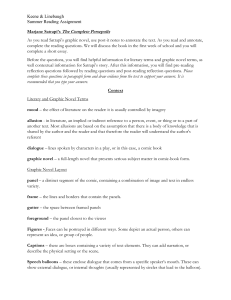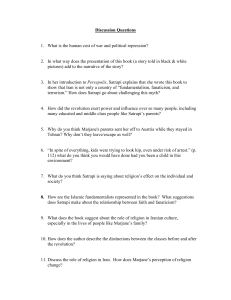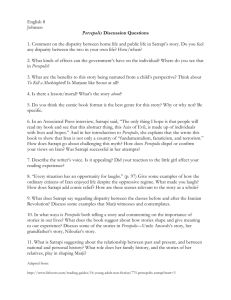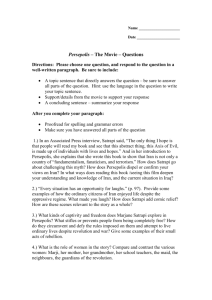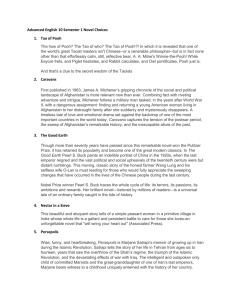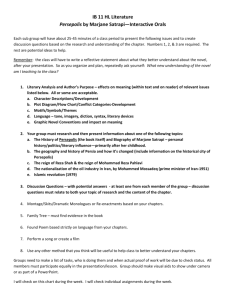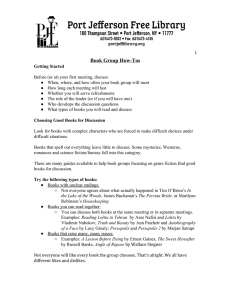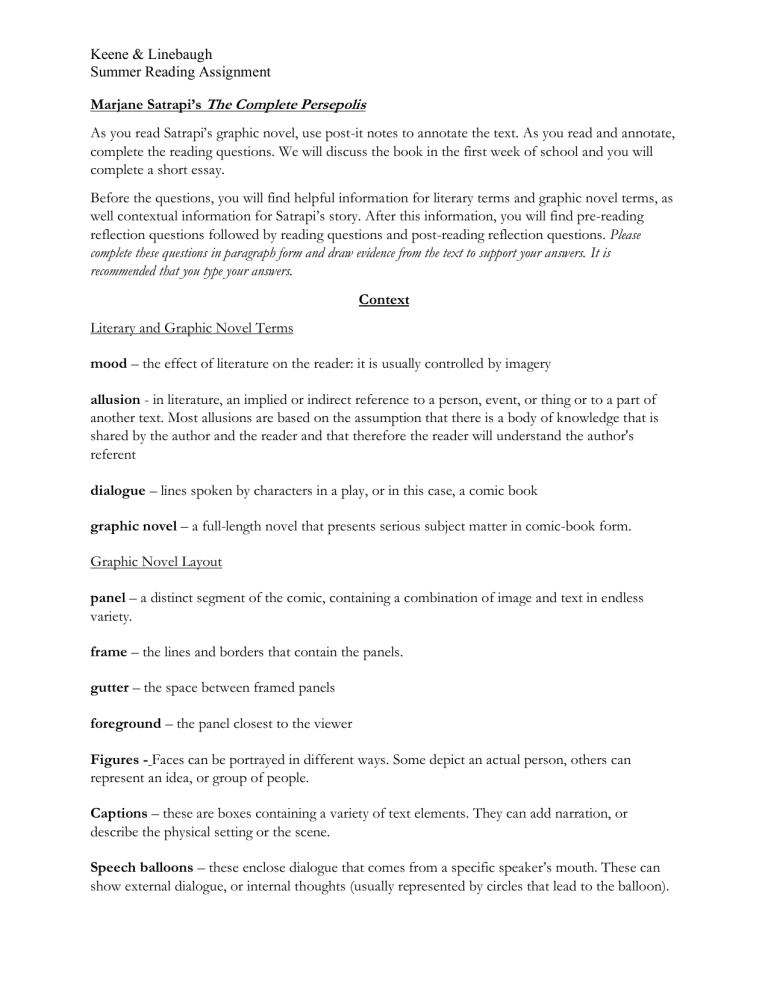
Keene & Linebaugh Summer Reading Assignment Marjane Satrapi’s The Complete Persepolis As you read Satrapi’s graphic novel, use post-it notes to annotate the text. As you read and annotate, complete the reading questions. We will discuss the book in the first week of school and you will complete a short essay. Before the questions, you will find helpful information for literary terms and graphic novel terms, as well contextual information for Satrapi’s story. After this information, you will find pre-reading reflection questions followed by reading questions and post-reading reflection questions. Please complete these questions in paragraph form and draw evidence from the text to support your answers. It is recommended that you type your answers. Context Literary and Graphic Novel Terms mood – the effect of literature on the reader: it is usually controlled by imagery allusion - in literature, an implied or indirect reference to a person, event, or thing or to a part of another text. Most allusions are based on the assumption that there is a body of knowledge that is shared by the author and the reader and that therefore the reader will understand the author's referent dialogue – lines spoken by characters in a play, or in this case, a comic book graphic novel – a full-length novel that presents serious subject matter in comic-book form. Graphic Novel Layout panel – a distinct segment of the comic, containing a combination of image and text in endless variety. frame – the lines and borders that contain the panels. gutter – the space between framed panels foreground – the panel closest to the viewer Figures - Faces can be portrayed in different ways. Some depict an actual person, others can represent an idea, or group of people. Captions – these are boxes containing a variety of text elements. They can add narration, or describe the physical setting or the scene. Speech balloons – these enclose dialogue that comes from a specific speaker’s mouth. These can show external dialogue, or internal thoughts (usually represented by circles that lead to the balloon). Keene & Linebaugh Summer Reading Assignment Historical Context Persepolis: an ancient city in Iran (see map at the bottom of the page) and the ancient capital to the of the kings of the Achaemenian dynasty of Iran (Persia), located about 30 miles (50 km) northeast of Shīrāz in the Fars region of southwestern Iran. The site lies near the confluence of the Pulvār (Sīvand) and Kor rivers. In 1979 the ruins were designated a UNESCO World Heritage site. the Shah - (formerly, in Iran) king; sovereign. There were two, the original Shah’s son was overthrown in the 1979 Islamic Revolution. Islamic Revolution – Iran 1979 – a state of revolt when the Iranian Shah was overthrown and an Islamic theocracy was put in place. Zarathustra - 6th century b.c., Persian religious teacher. Fidel Castro - A Cuban political leader of the twentieth century. He led the revolution that in 1959 overthrew the dictator of Cuba, who had the support of the United States. Castro then presided over his country's transformation into a communist state. Che Guevara - Theoretician and tactician of guerrilla warfare and prominent figure in Fidel Castro's revolution in Cuba (1956–59). Trotsky, Leon, 1879-1940, Russian Communist revolutionary, one of the principal leaders in the establishment of the USSR Hossein Fatemi, PhD - was a famous politician of Iran, born in 1919 in Nain and was executed on 10 November 1954. He proposed the thesis of nationalization of Iranian oil and gas assets to Premiere Mossadegh Keene & Linebaugh Summer Reading Assignment Pre-Reading Reflection Questions 1.) What are your perceptions of Iran? Why do you have these perceptions? 2.) How do you think reading a graphic novel will be different from reading a novel? (Your answer should be more than “a graphic novel has pictures”) Reading Questions Nota Bene: As you read Persepolis, answer these questions. Do not think that once you have answered a question initially that you are done with that question. Your answers will be checked for depth, evidence, and thoroughness. 1. According to the introduction, what stereotypical image is Satrapi trying to dispel? 2. As you read the book: Is she successful at dispelling this image in her story? Why/why not? How? 3. How does religion define certain characters in Persepolis?—Refer to the characters by name and provide evidence. A.) At the beginning? B.) In the middle? C.) At the end? 4. Is Satrapi making a social commentary on religion, and in particular on fundamentalism? If so, what is that social commentary? If not, what is she saying about religion? (You may need to look up fundamentalism to gain a better understanding of it and how it functions in the novel) a. What is Satrapi saying about religion’s effect on the individual? b. What is Satrapi saying about religion’s effect on society? Keene & Linebaugh Summer Reading Assignment 5. In what ways is Persepolis both telling a story and commenting on the importance of stories in our lives? a. What does the book suggest about how stories shape and give meaning to our experiences? b. Discuss the importance of some of the stories in Persepolis—Uncle Anoosh’s story, her grandfather’s story, Niloufar’s story. 6. How is Satrapi shaped/influenced by her family history, her relatives’ stories, her nation’s history? 7. What is the role of women in the story? Using analysis supported with evidence from the story, compare and contrast these women: Marji, her mother, her grandmother, her school teachers, the maid, the neighbors, the guardians of the revolution. Post Reading Reflection 1. After reading Persepolis, what are your perceptions of Iran? a. How does your answer after reading the book compare/contrast to your initial perceptions? Use evidence from the book to support your answer. 2. Why did Satrapi choose to tell her story in the form of a graphic novel? Is this genre effective for telling her story? Why/why not? Use evidence from the book to support your answer.
